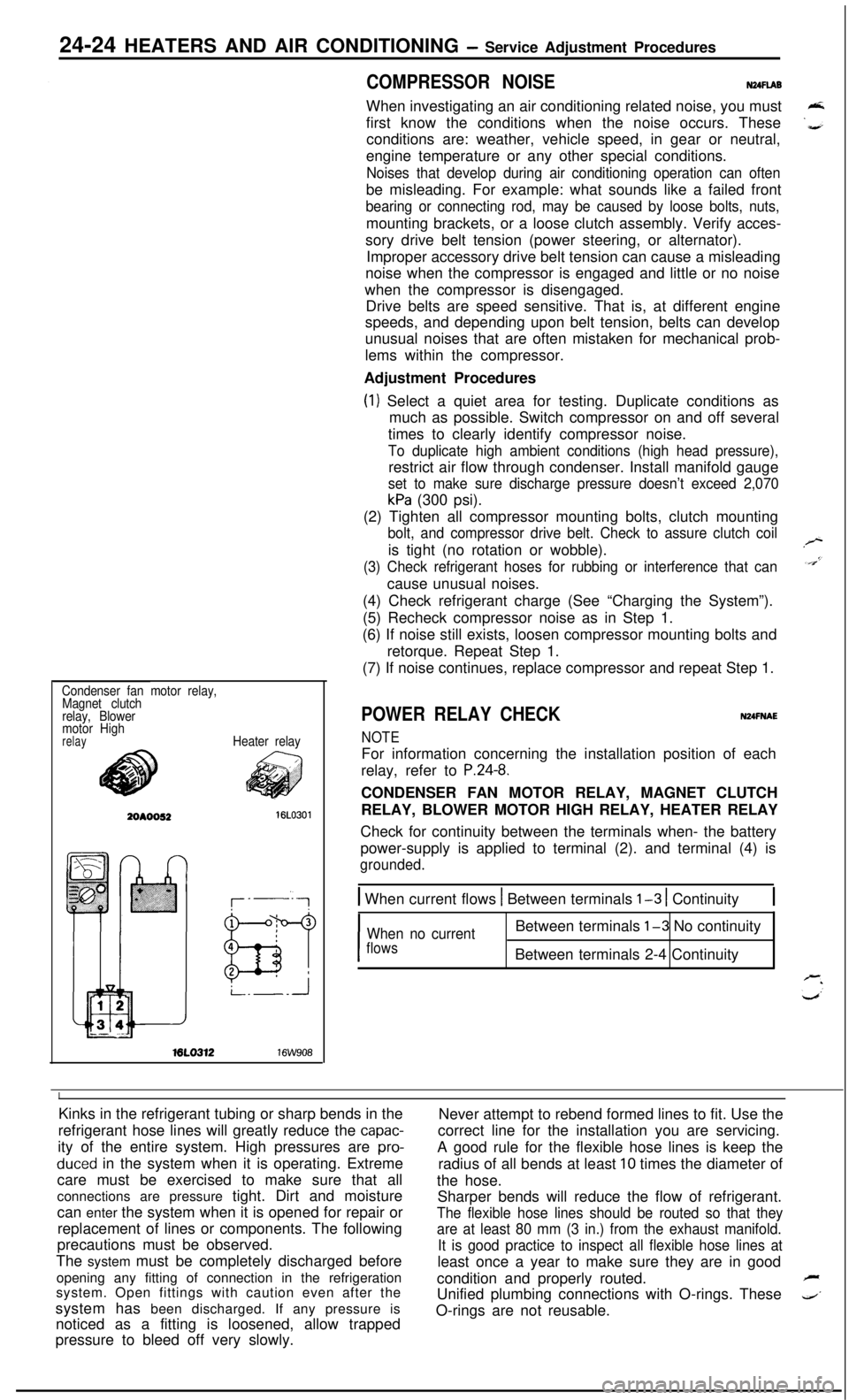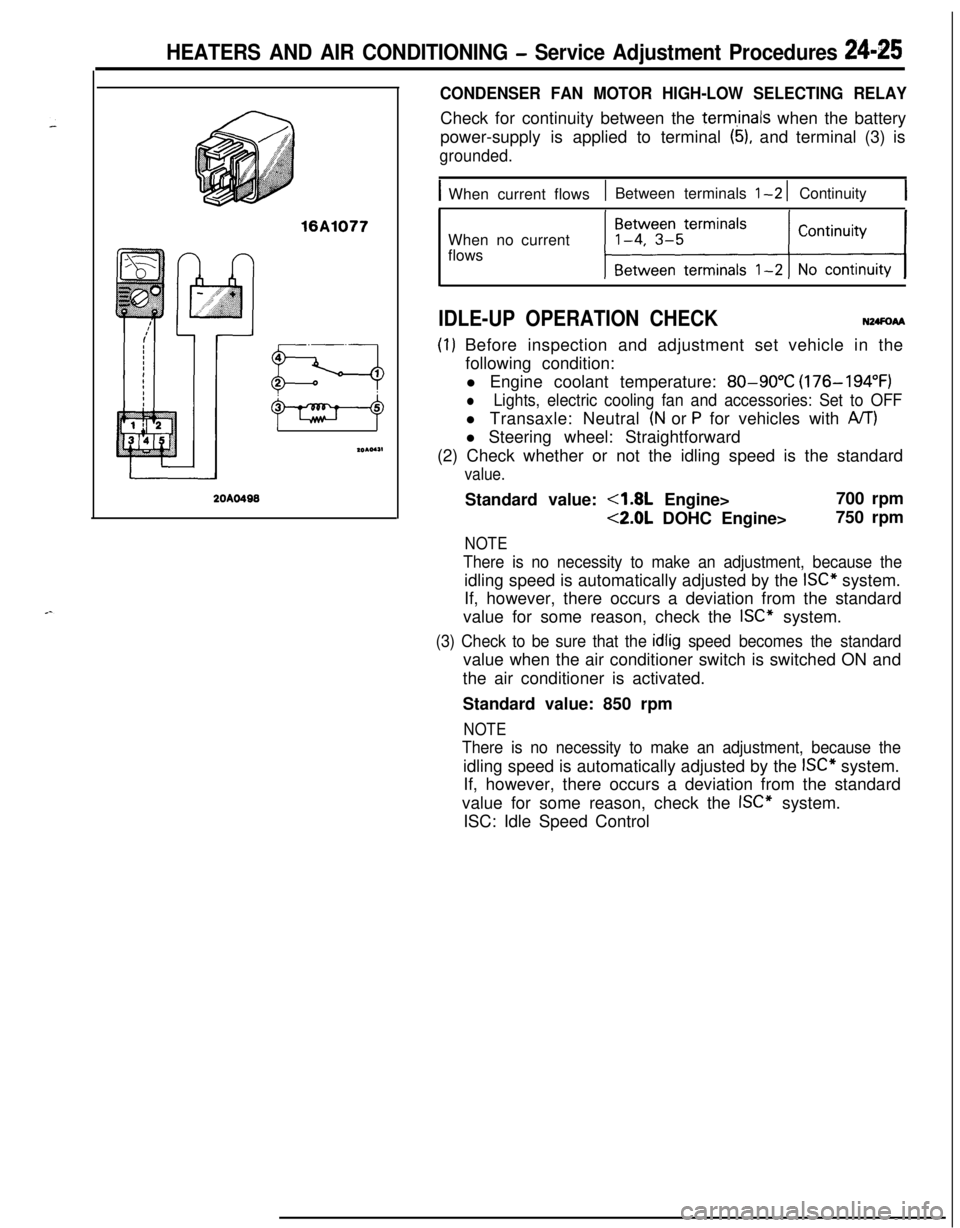1991 MITSUBISHI ECLIPSE power steering
[x] Cancel search: power steeringPage 691 of 1216

STEERING - Power Steering Oil Pump
Terminal assembly
13K753Mark
A,B or C-43Mark
A,B or C
13G0151
/Connector13K752
Suction-ring
25.123. INSTALLATION OF O-RINGSApply specified fluid on O-rings to install.
Specified fluid: MOPAR ATF PLUS (Automatic Transmis-sion Fluid Type 7176)/Automatic trans-
mission fluid “DEXRON” or “DGXRON II”
I No. II.D. x Widthmm (in.)1 Identification color 1
113x1.9t.51x.0748)Blue
23.8
x1.9l.15x.0748)-16. INSTALLATION OF FLOW CONTROL VALVE
(1) If the flow control valve is to be replaced, install the flowcontrol valve to the oil pump body corresponding with
the body identification mark (A,
6, C).
(2) Apply the specified fluid to the outside of the flow control
valve.
Specified fluid:MOPAR ATF PLUS (Automatic Trans-mission Fluid Type
7176)/htomatictransmission fluid “DEXRON” or
“DEXRON II”
15. INSTALLATION OF O-RINGS
Apply specified fluid on O-rings to install.
Specified fluid: MOPAR ATF PLUS (Automatic Transmis-sion Fluid Type 7176)/Automatic trans-
mission fluid “DEXRON” or “DlkXRON II”
No.I.D. x Widthmm (in.)
1I 1 x 1.9 t.43 x .0748)
213x 1.9 l.51 x .0748)
317.8 x 2.4 j.70 X .0945)
413.5 x 1.5 t.53 x .0590)
ldentificaqion color
Yelllow
Blue
-
Red13. INSTALLATION OF OIL SEAL
Drive the oil seal into the pump body.
12. INSTALLATION OF O-RING
Apply specified fluid on O-ring to install.
Specified fluid:MOPAR ATF PLUS (Automatib Transmis-sion Fluid Type 7176)/Autoniatic trans-
mission fluid “DEXRON” or “DEXRON II”I.D.
x Widthmm (in.)Identification color
I17.8 x 2.4 (.70 x .0945)-I
13A0277
Page 692 of 1216

19-44STEERING - Power Steering Oil Pump
13AO350
13PO159
Punch mark
13c214 I
13W03ECutouts for
dowel pin
13PO16110. INSTALLATION OF
O-RING/S. O-RING
Apply specified fluid on O-ring to install.
-,Specified fluid: MOPAR ATF PLUS (Automatic
Trans- ”mission Fluid Type 7176)/Automatic
transmission fluid
“DEXRONY or “DE-XRON II”
1 No. 1I.D. x Widthmm (in.)Identification color
I2 1I47.2 16.8x x2.4 2.4(1.86 (.66x x.0945) .0945)- -8. INSTALLATION OF SIDE
PLATE
Align the dowel pin of the pump body with the dowel pin holeof the side plate to install the side plate.
6.
INSTALLATlON OF ROTOR
Install the rotor to the pulley assembly so that the rotor’s
punch mark is at the pump cover side.
s,5. INSTALLATION OF SNAP RING
Lift the rotor and check to be sure that the snap ring is in the
countersunk part.4.
INSTALLATlON OF VANE/3. CAM RING
(I1 Apply specified fluid to vane and cam ring friction
surface.
Specified fluid: MOPAR ATF PLUS (Automatic Trans-mission Fluid Type 7176)IAutomatic
Atransmission fluid “DEXRON” or
“DEXRON II”
(21 Align the dowel pins of the pump body with the dowel
holes of the cam ring, and then install so that the cam
ring’s punch mark is at the pump body side.
Page 693 of 1216

STEERING - Power Steering Oil Pump
Direct round edge
to the cam
ringCam ring13R0577
(3)Apply specified fluid to the vanes and instafl :lhe yaneson the rotor, paying close attention to the installation
direction.,L.,., ‘,, :.I
Specified fluid:MOPAR ATF PLUS (Automatic Trans-mission Fluid Type
7176)/Auto@tictransmission fluid
“DEXFhOW’ or
“DEXRON II”
2. INSTALLATION OF O-RING
Apply specified fluid to O-ring and install firmly on oil pump
body.
Specified fluid: MOPAR ATF PLUS (Automatic Trans-
mission Fluid Type 7176)/Automatic
transmission fluid “DEXRON” or
“DEdXRON II”.
1.
INSTALLATlON OF PUMP COVER
(1) Apply specified fluid to rotor friction surface of pump
cover.
Specified fluid:MOPAR ATF PLUS (Automatic Trans-
mission Fluid, Type
7176)/Automatictransmission fluid “DEXRON” or
“DEXRON II”.
(2) Align the dowel pin of the pump cover with the dowel pinhole in the cam ring to install the pump cover.
Page 694 of 1216

19-46STEERING - Power Steering Hoses
POWER STEERING HOSESREMOVAL AND INSTALLATIONNlSTA-
Pre-removal Operationl C+?ing of the Power Steering
,‘; ,L..,.,.):. ,4-14 NmwaI. . .-...5-10 ft.lbs.7
I9-14 NmI7 7-10 ft.lbs.
Post-installation Operationl Supplying of the Power Steering-.
1 Fluid
l Bleeding of the Power Steering
Fluid Line(Refer to P.19-13.1,621 N/-@b
K
2
3.0-4.5 Nm /2-3 ft.lbs.I/II z-”a.
413A0274
Removal steps
1.Returnhose2.Suctionhose
3.Returnhose4. Cooler tube
5. Return tube
6. Rubber hose
.a 7. Pressure hose
8.Pressure tube9.Return tube
10.O-ring
NOTE(1) Reverse the removal procedures to reinstall.
(2) l a : Refer to “Service Points of Installation”.(3) q : Non-reusable partsWhite lineUP0143SERVICE POINTS OF INSTALLATION
NlSTDAD7. INSTALLATION OF PRESSURE HOSE
(1) Connect the pressure hose so that its slit pat-t contacts
the oil pump’s guide bracket.
(2) When the pressure hose is installed, align the white line
on the pressure hose with the white line on the pressuretube so that together they form a straight line.
Page 912 of 1216

2l-218AUTOMATIC TRANSAXLE - Transaxle Control
724
169-14
Nm7-10 ftlbs.7
\\4-6 Nm3-4 ft.lbs.3-4
ft.lbs.
Key interlock cable removal steps
1. Plug2. Side cover(B)
3. Power
(PWR)/Economy (ECO) switch
4. Side cover(B)
5. Cover
(B)6. Cup holder7. Carpet
8.
;ir;eystion of floor console wiring
9. Guide ring
10. Shoulder belt
12. Plug
13. Knee protector assembly
14. Hood lock release handle
15. Lap cooler duct and shower duct
(L.H.)16. Column cover
17. Snap pin
l + 18. Key interlock cable (selector lever
assembly side)
19. Clamp20. Cover
l + 21, Key interlock cable (steering lock
assembly side)
e+ 22. Slide lever
NOTE(I) Reverse the removal procedures to reinstall.(2) l 4 : Refer to “Service Points of Installation”.(3) Be sure to connect and adjust the transaxle control
cable before connecting the key interlock cable or shift
lock cable18'
‘1709A0138
Shift lock cable removal steps
1. Plug2. Side cover(B)
3. Power
(PWR)/Economv (EC01 switch
4. Side cover(B)
’5. Cover(B)
6. Cup holder7. Carpet
8. Connection of floor console wiring
harness9. Guide ring
10. Shoulder belt
11. Floor console
12. Plug13. Knee protector assembly
14. Hood lock release handle
15. Lap cooler duct and shower duct (L.H.)19. Clamp
l + 23. :izs lock cable (selector lever assembly24. Split pin
25. Shift lock cable (brake pedal side)
Page 1168 of 1216

24-24 HEATERS AND AIR CONDITIONING - Service Adjustment Procedures
COMPRESSOR NOISENUFIABWhen investigating an air conditioning related noise, you must
first know the conditions when the noise occurs. These
conditions are: weather, vehicle speed, in gear or neutral,
engine temperature or any other special conditions.
Noises that develop during air conditioning operation can oftenbe misleading. For example: what sounds like a failed front
bearing or connecting rod, may be caused by loose bolts, nuts,mounting brackets, or a loose clutch assembly. Verify acces-
sory drive belt tension (power steering, or alternator).
Improper accessory drive belt tension can cause a misleading
noise when the compressor is engaged and little or no noise
when the compressor is disengaged.
Drive belts are speed sensitive. That is, at different engine
speeds, and depending upon belt tension, belts can develop
unusual noises that are often mistaken for mechanical prob-
lems within the compressor.
Adjustment Procedures
(1) Select a quiet area for testing. Duplicate conditions as
much as possible. Switch compressor on and off several
times to clearly identify compressor noise.
To duplicate high ambient conditions (high head pressure),restrict air flow through condenser. Install manifold gauge
set to make sure discharge pressure doesn’t exceed 2,070
kPa (300 psi).
(2) Tighten all compressor mounting bolts, clutch mounting
bolt, and compressor drive belt. Check to assure clutch coilis tight (no rotation or wobble).
(3) Check refrigerant hoses for rubbing or interference that cancause unusual noises.
(4) Check refrigerant charge (See “Charging the System”).
(5) Recheck compressor noise as in Step 1.
(6) If noise still exists, loosen compressor mounting bolts and
retorque. Repeat Step 1.
(7) If noise continues, replace compressor and repeat Step 1.
Condenser fan motor relay,
Magnet clutch
relay, Blower
motor High
relayHeater relayML0312
16W908
POWER RELAY CHECKNUFNAE
NOTEFor information concerning the installation position of each
relay, refer to
P.24-8.CONDENSER FAN MOTOR RELAY, MAGNET CLUTCH
RELAY, BLOWER MOTOR HIGH RELAY, HEATER RELAY
Check for continuity between the terminals when- the battery
power-supply is applied to terminal (2). and terminal (4) is
grounded.
1 When current flows 1 Between terminals l-3 1 Continuity1
I
When no currentBetween terminals l-3 No continuity
flowsBetween terminals 2-4 Continuity
IKinks in the refrigerant tubing or sharp bends in the
Never attempt to rebend formed lines to fit. Use the
refrigerant hose lines will greatly reduce the
capac-correct line for the installation you are servicing.
ity of the entire system. High pressures are
pro-A good rule for the flexible hose lines is keep the
duced in the system when it is operating. Extreme
radius of all bends at least 10 times the diameter of
care must be exercised to make sure that all
the hose.
connections are pressure tight. Dirt and moisture
Sharper bends will reduce the flow of refrigerant.
can enter the system when it is opened for repair or
The flexible hose lines should be routed so that theyreplacement of lines or components. The following
are at least 80 mm (3 in.) from the exhaust manifold.precautions must be observed.
It is good practice to inspect all flexible hose lines atThe system must be completely discharged before
least once a year to make sure they are in good
opening any fitting of connection in the refrigeration
condition and properly routed.
Fsystem. Open fittings with caution even after the
Unified plumbing connections with O-rings. These
4’system has been discharged. If any pressure is
noticed as a fitting is loosened, allow trappedO-rings are not reusable.
pressure to bleed off very slowly.
Page 1169 of 1216

HEATERS AND AIR CONDITIONING - Service Adjustment Procedures 24-25
16A1077
20AO499
CONDENSER FAN MOTOR HIGH-LOW SELECTING RELAYCheck for continuity between the
term,inals when the battery
power-supply is applied to terminal
(5), and terminal (3) is
grounded.
IWhen current flows1 Between terminals l-2 1 Continuity1When no current
flows
IDLE-UP OPERATION CHECKN24FoAA
(I) Before inspection and adjustment set vehicle in the
following condition:
l Engine coolant temperature:
80-90°C (176-194°F)
lLights, electric cooling fan and accessories: Set to OFFl Transaxle: Neutral
(N or P for vehicles with A/T)l Steering wheel: Straightforward
(2) Check whether or not the idling speed is the standard
value.Standard value:
4.8L Engine>700 rpm
<2.0L DOHC Engine>750 rpm
NOTE
There is no necessity to make an adjustment, because theidling speed is automatically adjusted by the
ISC” system.
If, however, there occurs a deviation from the standard
value for some reason, check the
ISC” system.
(3) Check to be sure that the idlig speed becomes the standardvalue when the air conditioner switch is switched ON and
the air conditioner is activated.
Standard value: 850 rpm
NOTE
There is no necessity to make an adjustment, because theidling speed is automatically adjusted by the
ISC” system.
If, however, there occurs a deviation from the standard
value for some reason, check the
ISC” system.
ISC: Idle Speed Control